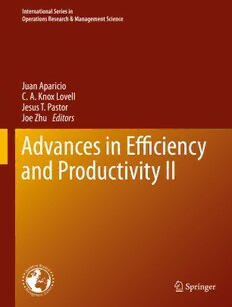
Advances in Efficiency and Productivity II PDF
Preview Advances in Efficiency and Productivity II
International Series in Operations Research & Management Science Juan Aparicio C. A. Knox Lovell Jesus T. Pastor Joe Zhu Editors Advances in Effi ciency and Productivity II International Series in Operations Research & Management Science Volume 287 SeriesEditor CamilleC.Price DepartmentofComputerScience,StephenF.AustinStateUniversity, Nacogdoches,TX,USA AssociateEditor JoeZhu FoisieBusinessSchool,WorcesterPolytechnicInstitute,Worcester,MA,USA FoundingEditor FrederickS.Hillier StanfordUniversity,Stanford,CA,USA The book series International Series in Operations Research and Management Science encompasses the various areas of operationsresearchandmanagementscience.Boththeoreticalandappliedbooksareincluded.Itdescribescurrentadvances anywhereintheworldthatareatthecuttingedgeofthefield.Theseriesisaimedespeciallyatresearchers,doctoralstudents, andsophisticatedpractitioners.Theseriesfeaturesthreetypesofbooks: • Advancedexpositorybooksthatextendandunifyourunderstandingofparticularareas. • Researchmonographsthatmakesubstantialcontributionstoknowledge. • Handbooksthatdefinethenewstateoftheartinparticularareas.Theywillbeentitled RecentAdvancesin(nameofthearea).Eachhandbookwillbeeditedbyaleadingauthorityintheareawhowillorganizea teamofexpertsonvariousaspectsofthetopictowriteindividualchapters.Ahandbookmayemphasizeexpositorysurveys orcompletelynewadvances(eitherresearchorapplications)oracombinationofboth. The series emphasizes the following four areas: Mathematical Programming: Including linear programming, integer programming, nonlinear programming, interior point methods, game theory, network optimization models, combinatorics, equilibrium programming, complementarity theory, multiobjective optimization, dynamic programming, stochastic pro- gramming, complexity theory, etc. Applied Probability: Including queuing theory, simulation, renewal theory, Brownian motionanddiffusionprocesses,decisionanalysis,Markovdecisionprocesses,reliabilitytheory,forecasting,otherstochastic processesmotivatedbyapplications,etc.ProductionandOperationsManagement: Includinginventorytheory,production scheduling, capacity planning, facility location, supply chain management, distribution systems, materials requirements planning, just-in-time systems, flexible manufacturing systems, design of production lines, logistical planning, strategic issues, etc. Applications of Operations Research and Management Science: Including telecommunications, health care, capital budgeting and finance, marketing, public policy, military operations research, service operations, transportation systems,etc. Moreinformationaboutthisseriesathttp://www.springer.com/series/6161 Juan Aparicio • C. A. Knox Lovell • Jesus T. Pastor • Joe Zhu Editors Advances in Efficiency and Productivity II Editors JuanAparicio C.A.KnoxLovell CenterofOperationsResearch SchoolofEconomics MiguelHernandezUniversity UniversityofQueensland Elche,Alicante,Spain Brisbane,QLD,Australia JesusT.Pastor JoeZhu CenterofOperationsResearch FoisieBusinessSchool MiguelHernandezUniversity WorcesterPolytechnicInstitute Elche,Alicante,Spain Worcester,MA,USA ISSN0884-8289 ISSN2214-7934 (electronic) InternationalSeriesinOperationsResearch&ManagementScience ISBN978-3-030-41617-1 ISBN978-3-030-41618-8 (eBook) https://doi.org/10.1007/978-3-030-41618-8 ©SpringerNatureSwitzerlandAG2020 Thisworkissubjecttocopyright.AllrightsarereservedbythePublisher,whetherthewholeorpartofthematerialisconcerned,specificallytherights oftranslation,reprinting,reuseofillustrations,recitation,broadcasting,reproductiononmicrofilmsorinanyotherphysicalway,andtransmissionor informationstorageandretrieval,electronicadaptation,computersoftware,orbysimilarordissimilarmethodologynowknownorhereafterdeveloped. Theuseofgeneraldescriptivenames,registerednames,trademarks,servicemarks,etc.inthispublicationdoesnotimply,evenintheabsenceofaspecific statement,thatsuchnamesareexemptfromtherelevantprotectivelawsandregulationsandthereforefreeforgeneraluse. Thepublisher,theauthors,andtheeditorsaresafetoassumethattheadviceandinformationinthisbookarebelievedtobetrueandaccurateatthedate ofpublication.Neitherthepublishernortheauthorsortheeditorsgiveawarranty,expressedorimplied,withrespecttothematerialcontainedhereinor foranyerrorsoromissionsthatmayhavebeenmade.Thepublisherremainsneutralwithregardtojurisdictionalclaimsinpublishedmapsandinstitutional affiliations. ThisSpringerimprintispublishedbytheregisteredcompanySpringerNatureSwitzerlandAG Theregisteredcompanyaddressis:Gewerbestrasse11,6330Cham,Switzerland Contents PartI Background Introduction ................................................................................................................... 3 JuanAparicio,C.A.KnoxLovell,JesusT.Pastor,andJoeZhu PartII MethodologicalAdvances NewDefinitionsofEconomicCross-efficiency............................................................................. 11 JuanAparicioandJoséL.Zofío EvaluatingEfficiencyinNonhomogeneousEnvironments ............................................................... 33 SoniaValeriaAvilés-Sacoto,WadeD.Cook,DavidGüemes-Castorena,andJoeZhu TestingPositiveEndogeneityinInputsinDataEnvelopmentAnalysis................................................. 53 JuanAparicio,LidiaOrtiz,DanielSantin,andGabrielaSicilia ModellingPollution-GeneratingTechnologies:ANumericalComparisonofNon-parametricApproaches ....... 67 KHervéDakpo,PhilippeJeanneaux,andLaureLatruffe OntheEstimationofEducationalTechnicalEfficiencyfromSampleDesigns:ANewMethodologyUsing RobustNonparametricModels.............................................................................................. 87 JuanAparicio,MartínGonzález,DanielSantín,andGabrielaSicilia LocalCircularityofSixClassicPriceIndexes............................................................................. 107 JesúsT.PastorandC.A.KnoxLovell RobustDEAEfficiencyScores:AHeuristicfortheCombinatorial/ProbabilisticApproach......................... 125 JuanAparicioandJuanF.Monge PartIII EmpiricalAdvances CorporateSocialResponsibilityandFirms’DynamicProductivityChange........................................... 145 MagdalenaKapelko ANovelTwo-PhaseApproachtoComputingaRegionalSocialProgressIndex....................................... 159 VincentCharles,TatianaGherman,andIoannisE.Tsolas ATwo-LevelTop-DownDecompositionofAggregateProductivityGrowth:TheRoleofInfrastructure .......... 173 LuisOrea,InmaculadaÁlvarez-Ayuso,andLuisServén EuropeanEnergyEfficiencyEvaluationBasedontheUseofSuper-EfficiencyUnderUndesirableOutputs inSBMModels ................................................................................................................ 193 RobertoGómez-Calvet,DavidConesa,AnaRosaGómez-Calvet,andEmiliTortosa-Ausina ProbabilityofDefaultandBankingEfficiency:HowDoestheMarketRespond?..................................... 209 ClaudiaCuriandAnaLozano-Vivas v vi Contents MeasuringGlobalMunicipalPerformanceinHeterogeneousContexts:ASemi-nonparametricFrontier Approach....................................................................................................................... 221 JoséManuelCordero,CarlosDíaz-Caro,andCristinaPolo TheImpactofLandConsolidationonLivestockProductioninAsturias’Parishes:ASpatial ProductionAnalysis........................................................................................................... 239 InmaculadaÁlvarez,LuisOrea,andJoséA.Pérez-Méndez Index............................................................................................................................ 261 Part I Background Introduction JuanAparicio,C.A.KnoxLovell,JesusT.Pastor,andJoeZhu Abstract Webeginbyprovidingcontextualbackgroundofthisbook,thesecondinaseries.Wecontinuebyproclaiming theimportanceofefficiencyandproductivity,forbusinesses,industries,andnations.Wethensummarizethechaptersinthe book,whichconsistofanequalnumberofadvancesintheanalyticalfoundationsofefficiencyandproductivitymeasurement andadvancesinempiricalapplicationsthatillustratethesignificanceofefficiencyandproductivity. Keywords Efficiency · Productivity · Analyticaladvances · Empiricalapplications 1 Background The Santander Chair of Efficiency and Productivity was created at the Miguel Hernandez University (UMH) of Elche, Spain, at the end of year 2014. Its aim was, and continues to be, the promotion of specific research activities among the international academic community. This Research Chair was assigned to the UMH Institute CIO (Center of Operations Research). The funding of the Chair by Santander Universidades constitutes one more example of the generosity and the visionofthisorganization,whichsupportsanetworkofover1407Ibero-Americanuniversitiesandover19.9millionstudents andacademicians.ProfessorKnoxLovell,HonoraryProfessorofEconomicsattheUniversityofQueensland,Australia,was appointed Director of the Chair. The Advisory Board of the Chair consists of four members, two of them on behalf of SantanderUniversidades,Mr.JoséMaríaGarcíadelosRíosandMr.JoaquínManuelMolina,andtheothertwoonbehalf oftheUMH,Ph.D.JuanAparicio,appointedasCo-Director,andPh.D.LidiaOrtiz,theSecretaryoftheChair. During 2015 and 2016, the Chair organized eight Efficiency/Productivity Seminars for starting new programs with researchers interested in a variety of topics such as education, municipalities, financial risks, regional cohesion, meta- heuristics, renewable energy production, food industry, and endogeneity. During 2015, an International Workshop on EfficiencyandProductivitywasorganized.TheWorkshopcontributionsof15relevantresearchersandresearchgroupsmade itpossibletoconceivethefirstbookinthisseries,AdvancesinEfficiencyandProductivity,withtheinestimablesupportof ProfessorJoeZhu,theAssociateSeriesEditorfortheSpringerInternationalSeriesinOperationsResearchandManagement Sciences. During2017–2019,theChairorganizedtenseminarsontopicssuchasfinancialefficiency,conditionalefficiencyapplied to municipalities, analysis of the change in productivity through dynamic approaches, measures of teacher performance in education, meta-heuristic approaches, centralized reallocation of human resources, evaluation of the impact of public policies,andcomparativeevaluationoftheperformanceoftheinnovationintheEuropeanUnion.Additionally,inJune2018, asecondInternationalWorkshoponEfficiencyandProductivitywasorganizedinthecityofAlicante,andthecontributions oftheparticipantsarecollectedinthisvolume,naturallyentitledAdvancesinEfficiencyandProductivityII.ProfessorJoe Zhuhasgraciouslyagreedtojointheeditorsofthisvolume. J.Aparicio((cid:2))·J.T.Pastor CenterofOperationsResearch(CIO),UniversityMiguelHernándezofElche, Elche,Alicante,Spain e-mail:[email protected] C.A.K.Lovell CentreforEfficiencyandProductivityAnalysis,UniversityofQueensland,Brisbane,Australia J.Zhu SchoolofBusiness,WorcesterPolytechnicInstitute,Worcester,MA,USA ©SpringerNatureSwitzerlandAG2020 3 J.Aparicioetal.(eds.),AdvancesinEfficiencyandProductivityII,InternationalSeriesinOperationsResearch&Management Science287,https://doi.org/10.1007/978-3-030-41618-8_1 4 J.Aparicioetal. 2 AdvancesinEfficiency and Productivity The title of this book, like the title of the first book, is generic, but the two substantive components, efficiency and productivity, are of great concern to every business and economy, and to most regulators as well. The first word in the title is the theme of the book and of the 2018 International Workshop on Efficiency and Productivity that spawned it. The presentations at the workshop, and the chapters in this book, truly do advance our understanding of efficiency and productivity. Thetheoreticaldefinitionofefficiencyinvolvesacomparisonofobservedinputs(orresources)andoutputs(orproducts) with what is optimal. Thus, technical efficiency is the ratio of observed to minimum input use, given the level of outputs produced, or as the ratio of observed to maximum output production, given the level of input use, or any of several combinations of the two, with or without additional constraints. Each type of technical efficiency is conditional on the technologyinplace,andeachisindependentofprices.Incontrast,economicefficiencyisprice-dependentandtypicallyis definedastheratioofobservedtominimumcost,givenoutputsproducedandinputpricespaid,orastheratioofobserved tomaximumrevenue,giveninputsusedandoutputpricesreceived.Therearevariantsofthesedefinitionsbasedondifferent measuresofvalue,suchastheratioofobservedtomaximumprofit,butalltaketheformofacomparisonofobservedvalues withoptimalvalues,conditionalonthetechnologyinplace.Itisalsopossible,andusefulforconveyingfinancialinformation tomanagements,toconvertallratiosabove,technicalandeconomic,todifferencesexpressedinunitsoftherelevantcurrency. Indeedmanyimportantrecentanalyticaladvances,includingsomeinthisbook,measureeconomicperformanceintermsof differencesratherthanratios. Theprincipalchallengeinefficiencymeasurementisthedefinitionofminimum,maximum,oroptimum,eachofwhich isarepresentationoftheunobservedproductiontechnology,whichthereforemustbeestimated.Theanalyticaltechniques developedinthisbookprovidealternativewaysofdefiningoptimum,typicallyasa(technical)productionfrontierorasan (economic)cost,revenue,orprofitfrontier,andalternativewaysofmeasuringefficiencyrelativetoanappropriatefrontier. Theconceptoffrontiers,anddeficitsorgapsorinefficienciesrelativetothem,playsaprominentroleintheglobalwarming andclimatechangeliterature,reflectingthefactthatsomenationsaremoreatriskthanothers. The theoretical definition of productivity coincides with the common sense notion of the ratio of observed output to observed input. This definition is straightforward on the rare occasion in which a producer uses a single input to produce asingleoutput.Thedefinitionismorecomplicatedotherwise,whenmultipleoutputsinthenumeratormustbeaggregated usingweightsthatreflecttheirrelativeimportance,andmultipleinputsinthedenominatormustbeaggregatedinasimilar fashion,sothatproductivityisagaintheratiooftwoscalars,aggregateoutputandaggregateinput.Thetimepathofaggregate output is an output quantity index, and the time path of aggregate input is an input quantity index. Productivity growth is then defined as the rate of growth of the ratio of an output quantity index to an input quantity index or, equivalently, as the rate of growth of an output quantity index less the rate of growth of an input quantity index. Market prices are natural choicesforweightsinthetwoindexes,providedtheyexistandtheyarenotdistortedbymarketpower,regulatoryorother phenomena. As with efficiency measurement, productivity measurement can be expressed in terms of differences rather thanratios,inwhichcaseproductivityindexesbecomeproductivityindicators.Alsoaswithefficiencymeasurement,many importantrecentanalyticaladvances,includingsomeinthisbook,measureproductivityperformancewithdifference-based indicatorsratherthanwithratio-basedindexes. Twochallengesmustbeovercome,oratleastaddressed,inproductivitymeasurement.Thefirstinvolvesthemathematical structureoftheaggregatorfunctionsemployedtoconvertindividualoutputsandinputstooutputindexesorindicatorsand inputindexesorindicators.Thischallengeismentionedfrequentlyinthisbook.Thesecondisanextensionofthefirstand occurs when prices do not exist or are unreliable indicators of the relative importance of corresponding quantities. In this case,productivityanditsrateofgrowthmustbeestimated,ratherthancalculatedfromobservedquantitiesandprices.The analyticaltechniquesdevelopedinthisbookprovidealternativemethodsforestimatingproductivityandproductivitychange throughtimeorproductivityvariationacrossproducers. Theconcepts ofefficiency andproductivityaresignificantbeyond academe andcharacterize twoimportantdimensions oftheperformanceofbusinessesandeconomies,asevidencedbythefollowingexamples: • The financial performance of businesses depends on the efficiency with which they conduct their operations. Statista, a financialstatisticsprovider,hasrankedthebankingsystemsinselectedEuropeancountriesbytheircost-incomeratio,the ratio of the cost of running operations to operating income, a traditional measure of operating efficiency in banking. In 2018itfoundBelgianbankstobethemostcost-efficient,withacost-incomeratioof38.1%,andGermanbankstobethe least cost-efficient, with a cost-income ratio of 81.8%. The five most efficient national banking systems had an average cost-incomeratioof44.3%,whilethefiveleastefficientnationalbankingsystemshadanaverageratioof69.4%.Itseems
